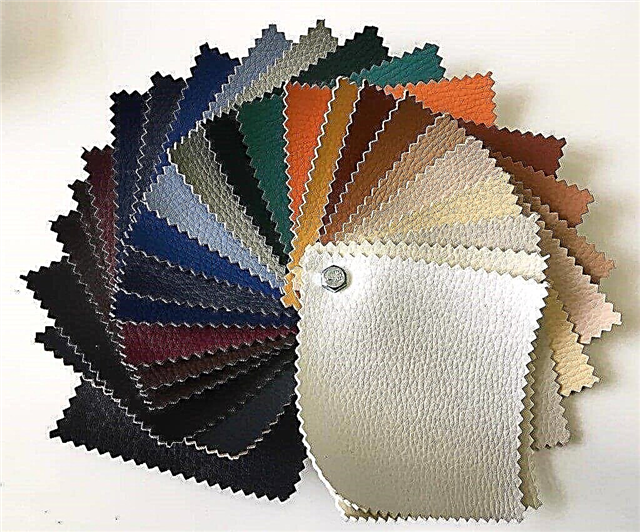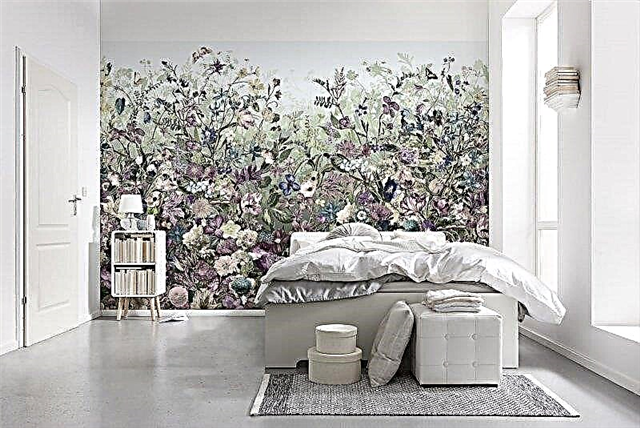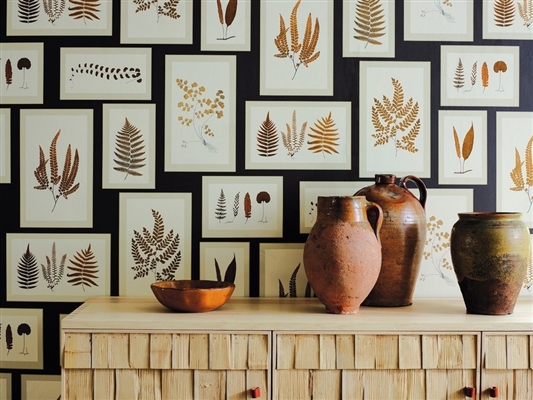
Complex and incomprehensible layouts are the scourge of many typical apartments, both the old and the new fund. Especially problems arise when you need to equip a room with some massive large element. For example, a narrow bedroom, in which, whatever one may say, you need to put a bed. Now let's figure out how to do it!
Features of planning and design
To harmonize a narrow room, you need to understand first of all with verticals and horizontals. A clear horizontal line along the walls visually pushes them apart. But if you do not dilute it with accents, then you can get the effect of a compartment car. Put a low ottoman at the high cabinet, and a pot with your favorite ficus at the shelf.
Get rid of clear boundaries: you will be helped by a ceiling in the color of walls and wide skirtings-sills. Rounded lines smooth the angularity: a corner radial closet, round pillows, a semicircular countertop for the dressing table. In narrow rooms, such furniture is also safer - you will not constantly stumble on the aisle.

Narrow bedroom in a modern style
This is precisely the fine line between classics, fashion trends and even high-tech. Choose a bed and furniture of simple geometric shapes, but compensate for this with interesting shades. The rigor of a tree is balanced by frameless mirrors, interesting fittings and modern storage systems. Use colors that are natural, but complex and multicomponent: instead of white - milky, instead of yellow - mustard, and then in the same vein.

Narrow classic bedroom
Classic tricks are easy to apply in a narrow room, if adapted to an elongated layout. For example, instead of one center in the middle of the square, make two - in the bed area and against the opposite wall. If you want massive cabinets - let them be without excess thread and twisted legs, but with beautiful old furniture. Close joints and junctions with wide decorative sills and sockets.

Narrow Loft Style Bedroom
It is enough to leave a short wall by the bed of brick or concrete - and now almost no room to recognize. The loft a priori gives you all the cards in your hands - here you can find simple massive furniture, geometric accents, and mirrors with unusual shaped lamps. Instead of patterned wallpaper, take bright color posters or frames from comics.

Narrow Scandinavian style bedroom
The light Scandinavian style is very warm and cozy, so that it is well suited for the bedroom. Make the decoration as light, neutral and solid as possible, and then use contrasting black or color geometric and abstract motifs. Lovely handmade trinkets and as much greenery as possible will add cosiness and personality.

Narrow Provence style bedroom
The gentle pastel gamma of Provence fits perfectly into a cozy romantic bedroom, but it is better to dilute it with a neutral milk or beige base. Furniture made of bleached wood looks visually lighter than the dark classic. Deliberately rough long boards on the floor will perfectly complement the composition, and decoupage will decorate small accessories.
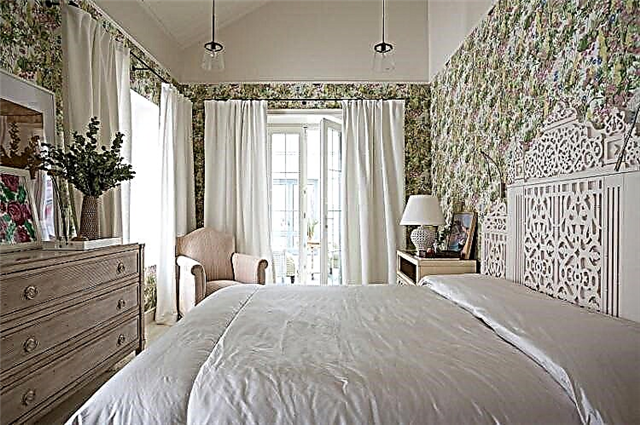
Color spectrum
Regardless of the layout, the bedroom is relaxing and relaxing, so minimize visual irritants. It is better to paint the walls in one neutral light color - warm beige, strict gray or delicate pastel. In a narrow room, monochrome interiors look good, where all the coatings and furniture are almost tone-on-tone, and the accents are created by textiles and accessories.

Floor finish
For the floor in a narrow bedroom, any rectangular boards are best suited: from classic parquet to modern laminate. The main thing is that the elongated modules go perpendicular to long walls and visually push them apart. And by the bed you can put a round fluffy and cozy carpet for the legs.

Wall decoration
Do not use too complex textures in a narrow bedroom: decorative plaster, wallpaper with large drawings. Panels, lining - all this looks too bulky. Stop on monophonic wallpaper or small local ornaments around the perimeter or in the form of a chaotic mosaic. If you want an accent wall, take the paint of several adjacent shades: lighter - on long, and darker - on short surfaces.

Ceiling design
A simple single-level plasterboard or stretch ceiling is ideal for a narrow bedroom. Keep in mind that the gloss will stretch the room even more, because the illusion of volume goes up. And he gives complex reflections and refractions, which are not always suitable for long rooms.
It looks interesting matte ceiling to match the walls or drywall, literally painted with the same paint. This gives the very effect of smoothing sharp joints and transitions. Delicate silky satin with a slight sheen and mother of pearl looks romantic. If you want several levels, do boxes along short walls.

How to arrange furniture in a narrow bedroom?
In any narrow room you need to use the space up, not in breadth. This means that instead of a chest of drawers, pay attention to sliding wardrobes to the ceiling, instead of chaotic decorative shelves, to high racks. To hide bedding and bedding, roomy boxes in the base of the catwalk bed are ideal.
Use mirrors on a wide wall: a few large ones, a composition of small ones or simply mirrored sliding doors. It is better to move the bed in a narrow wall opposite from the entrance so that it does not block the entire passage. Or put a built-in closet from wall to wall there - everything you need will fit in it, and the bedroom will seem squarer.
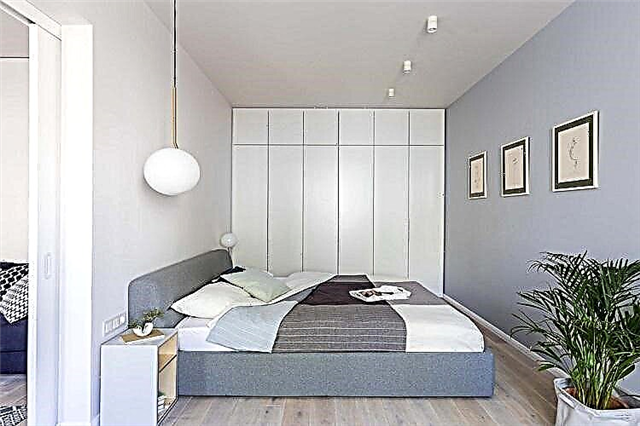
Lighting and backlight
The central chandelier gives more or less uniform light only in perfectly square rooms. For a narrow bedroom, spotlights along short walls are better - like floorboards, they push the room apart. At the bed, use compact sconces or stylish decoration nightlights.
If you need to highlight a chair by the bookshelf or dressing table - combine table lamps and floor lamps. If they are in the same style, but of different heights - this is just stylish work with verticals and horizontal lines. A romantic and slightly futuristic atmosphere is created by LED strip, which emphasizes the second level of the ceiling, the podium of the bed, shelf or mirror.

Decor and Textile
In the bedroom you can’t do without textiles, but nevertheless in the narrow room refuse too textured fabrics, voluminous curtains and other hyperbolic things. Heavy curtains, even at a short wall, will not correct the geometry, but only make the room heavier. It is better to choose thin fabrics on a blackout lining without complex lambrequins and multilayer compositions, or even rolled Roman curtains.
Decorate the bed with a bright bedspread and decorative pillows, which will just add dynamics. One of the same pillow can be thrown into a chair, on a windowsill or on a stool by the dressing table. Do not forget about bedding: instead of old chintz flowers, take a stylish plain satin.

Wall decoration
If you have an elongated room, you need to use wallpaper in contrasting colors, photo wallpapers with perspective to simulate additional volume, and a fabric that is quite popular now with a 3D effect is also suitable.
Our main task is to visually highlight short walls and distract attention from the long wall. This can be done at the expense of contrast: for a wall with a shorter length, you need to use deep, saturated colors, bright patterns, this is where the objects that attract attention should be. If a window is located on such a wall, it is worth highlighting it, you can use original curtains.
By the way, it is now fashionable to use draperies and blackout curtains not only for window decoration, but also for ordinary walls.
On the contrary, you need to divert attention from a long wall; light tones and a minimum of decorative elements are suitable for it.
Some designers recommend sticking here wall murals with a perspective, for example, landscapes with mountains going into the distance or endless valleys.
Another classic trick in the design of a small long room is to paste over the wall with stylish wallpaper with a vertical pattern, even ordinary solid stripes will do, and a short one with horizontal.
Experiment with textures and bright details, you can trim a part of the wall under a brick or use cork panels. Use big pictures, bright posters. Another great solution to diversify the interior of a long narrow room is niches in the walls, which become a real highlight in the design and allow you to get rid of the tunnel effect in the room.
Windows, doors and floors
Separately, it is worth talking about windows and doorways in narrow bedrooms or living rooms, as well as suitable floor coverings. When applying, adhere to the following recommendations from experienced designers:
- If your doorway is located on a long wall, it would be better to expand it and use spectacular swing doors with two leaves, platbands should be as wide as possible. If you do not need a closing door, you can arrange the opening in the form of a wide arch, it is better to trim its edges with contrasting materials to the wall decoration, choose a different color and texture.
- Windows located on the wall of a greater length, it is also better to visually increase, the opening itself can be made a bell with the extension to the side of the room. If the window is on a small wall, the opening should be strictly rectangular in shape.
- If you decide to visually expand the space in a narrow room, it is better to use a tile, laminate or linoleum with a rectangular geometric pattern for the floor. It is necessary to lay the floor so that the pattern is parallel to the narrow walls.
Basic zoning techniques
When considering the design of a long narrow room, be sure to use zoning techniques. The following items may be your assistants:
- stylish carpet
- podium,
- a compact sofa located across the premises,
- mobile partition or screen,
- light translucent curtains.
They will help to divide the living area into various functional centers: for example, to separate, at least visually, a sleeping place and a mini-office for work and leisure. This is the best solution for apartments with a limited area or a large number of residents, where the bedroom, for example, is not a place exclusively for relaxation. Using a screen or an air curtain, you can fence off a separate space for relaxation. Avoid using bulky wardrobes or heavy curtains for these purposes, otherwise you will just get two tiny rooms, and one of them will almost certainly turn out to be dark, with a lack of adequate natural light.
Furniture arrangement
Previously, it was customary to simply place all existing furniture along the walls, thereby making the narrow room visually even more elongated. Remember that the more free space there is, the better, so minimize the amount of furniture using only the most necessary. Due to this, the living room or bedroom will look wider, especially if you will group objects in separate zones, and not evenly arrange them along the walls. Asymmetric arrangement and distraction of furniture of different heights is also suitable.
Be sure to use tables of round or oval shape, this will radically change the visual proportions of the room itself. The best option for the cabinet is a sliding wardrobe with modern mirrored doors, it needs to be placed along one of the short walls, so you not only shorten the room a bit, but also use the space as functionally as possible. If you have a small room, it is best to order a wardrobe from floor to ceiling to place all things in it. This will allow you to abandon unnecessary and poorly functional small cabinets and chests of drawers cluttering up the space.
Pay attention to transforming furniture, especially if there is no way to place a dressing and computer desk.
Play of light
Another technique for visually changing the proportions of a room is the integrated use of a variety of modern light sources. Properly placing the LED light sources on the walls, you can focus on important interior items, highlight individual zones, all this allows you to visually increase the space itself.
A chandelier located habitually in the center of the ceiling will be inappropriate in a long room. If for you its availability is a matter of principle, choose an elongated model, you need to hang it across the room, that is, perpendicular to long walls. Use additional light sources to balance the chandelier, for example, place wall lights on short walls or place a floor lamp next to one of them. This will create an effective game of bright light, in addition, give a feeling of coziness, comfort.
Important: in no case do not place additional lamps on long walls if you do not want the room to look like a corridor.
As you can see, if you competently think about the interior of a narrow room, choose the right furniture and light sources, you can make it effective and comfortable for living. We hope our tips have been helpful to you. Go for it!
Layout problems of residential narrow rooms solved
Archival material. Published in 2016, updated in 2019. How to arrange furniture in a narrow room? It depends on what kind of narrow room it is: what is important for a narrow bedroom can be ignored when arranging a euro-guest.
EUROSTONE - BIG, BUT NARROW
The design of the long room comes from the new buildings of recent years: the kitchen and living room are combined into one room, the elongated side of a single window. The riser with communications, as a rule, is located at the entrance - this “ties” the kitchen to the far dark part of the room.
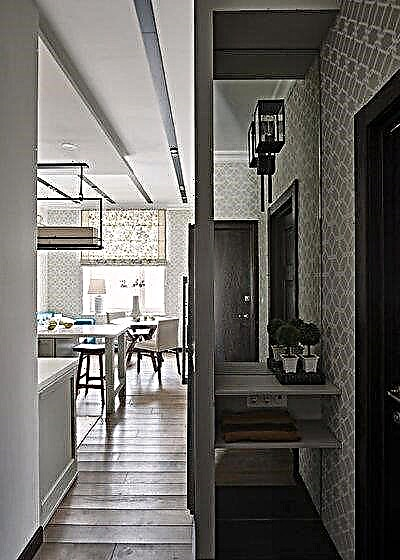

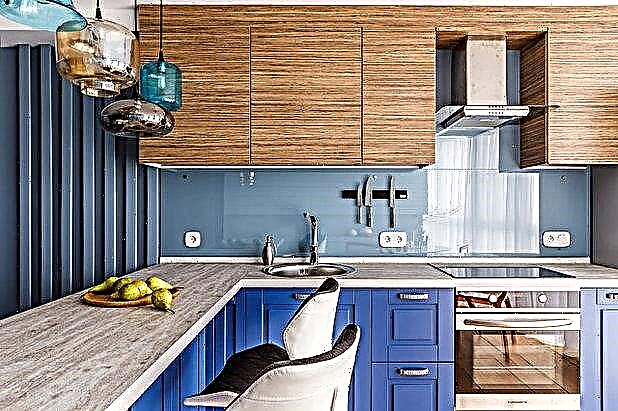
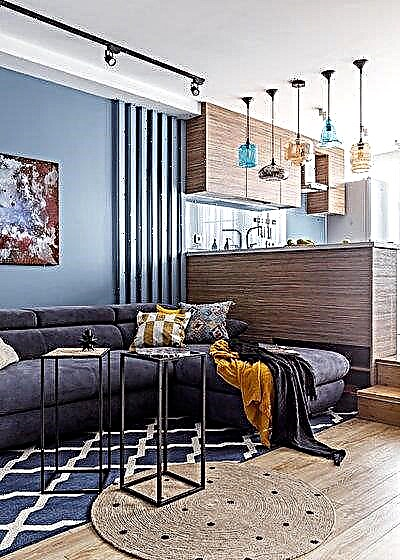
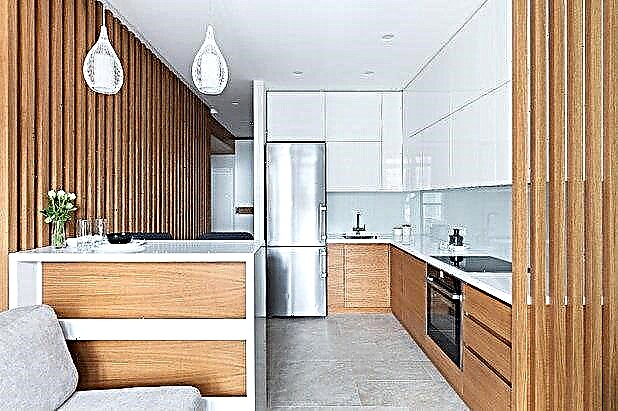

Important: The option is suitable if the loggia already has a similar glazing - without a lower blind parapet. Or in the kitchen a panoramic window to the floor.
If it is possible to reconcile the redevelopment with replacing the internal window unit with a French door, then it is impossible to replace the standard blind glazing with the floor option (this is a violation of the architectural appearance of the building).
Curtains play a decorative role - they frame the window. And the less often they will be pulled, the more pleasant it will be to stay indoors during the day.



NARROW KITCHEN-LIVING ROOM
The kitchen appendix coming into the living room is a frequent result of redevelopment with the addition of a previously isolated kitchen.
DANO: The only place for a table is usually located on the aisle. As a result, the chairs interfere with the movement - no matter which wall you move the table to.

DECISION. Rethink the design and decoration of a narrow room. Exclude the setting of chairs on the aisle in principle: due to the shape of the table, the way it is placed, or simply the number of chairs. In the photo above, the problem was solved by the built-in bench. Here - the shape of the bar and, again, the number of chairs purchased: the fifth person can only stand next to the bar - a seat for him is not consciously provided.
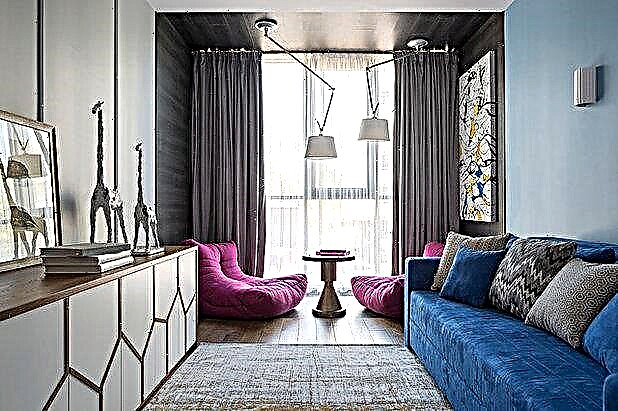
NARROW LITTLE LIVING ROOM
You need to figure out how to make a narrow room visually wider.
DECISION. The correct curtain from wall to wall (curtains for a narrow room must be hung so that the window seemed wider than it actually is). In this project, panels to match the curtains also work to expand the space (they frame the walls and ceiling in the area of the chairs).

NARROW PASSING LIVING ROOM
The design of such an elongated room is highly dependent on the location of the doors.If they are located on one axis (in the manner of enfilades), then the patch at the window “disappears”.
SOLUTION 1. Change the route a little. Instead of a direct passage - rounded around the table. Pay attention to the arrangement of furniture in a narrow room: there is no chair on the aisle (even though there is plenty of room for it), the sofa was also shifted from the axis to the left - now it does not interfere with movement.
4. Divide the room into zones

If the length of the room is at least one and a half times the width, it is worth doing zoning. This can be done by arranging the furniture, using a different (unlike most of the room) wall decoration, decor and additional lighting. And mirrors will help visually increase the space. Other examples of zoning can be found here.
5. We use the magic of lighting

Another ban for a narrow room is the only source of lighting. Especially if it is a bulky chandelier. For elongated rooms, designers choose chandeliers on a light frame with several shades, and then supplement them with lamps at the head of the bed or the back of the sofa, lamps above the desk, a garland at the mirror and other elements. A few examples here.
7. We place the horizontal on a long wall

The abundance of little things like photographs and paintings on one of the long walls will only enhance the impression of an elongated space. The same thing, however, will happen if you leave the wall empty. An alternative is a large horizontal in the middle of the wall. It can be a mirror, a panel or a picture. It is recommended to place such an element within the zone to which it belongs, but not at the border of two sections of the room.
8. We use blinds instead of curtains

If the room is not only narrow, but also small, for a small window in it it is more practical to use blinds or blinds. Ordinary curtains and curtains will “eat up” an already scarce space, and a laconic version will create coziness even in a small room.
Bonus: debunking the light wall myth

It is a mistake to believe that cream or pale beige shades will become a panacea on their own. On the contrary, the identical color of the short and long walls will “stretch” the room. There are two easy ways to avoid this.
Firstly, the window frames and doorways located in the end wall can be painted in a contrasting color. Such a technique would seem to bring these elements to the forefront, distracting from the shape of the room.
Secondly, you can act more radically and paint the entire end wall in a darker color. You can also use wallpaper with a brighter shade. The emphasis with the help of color visually “brings” the far wall to the center of the room, making the room not so narrow. In reality, at your disposal will remain the same square, suitable in order to create a cozy corner.
If you have your own experience in creating a comfortable space in a small or narrow room, share it in the comments.

